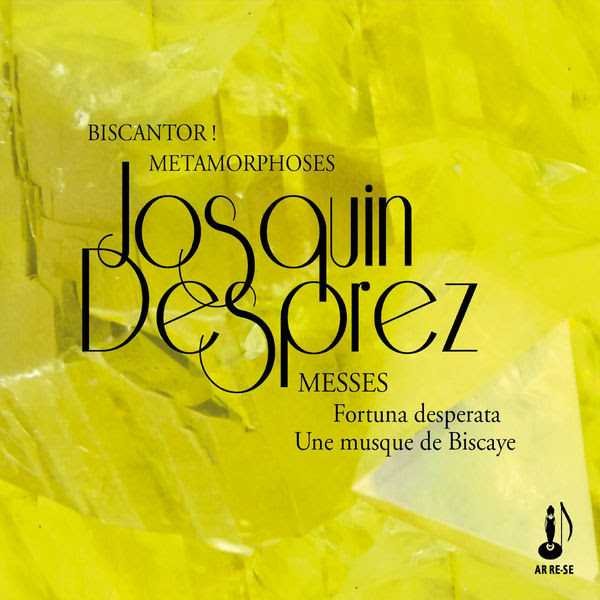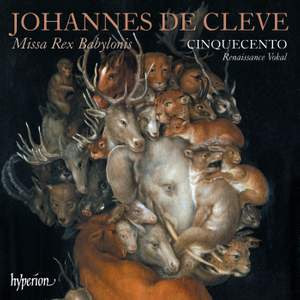Program: #20-28 Air Date: Jun 29, 2020
To listen to this show, you must first LOG IN. If you have already logged in, but you are still seeing this message, please SUBSCRIBE or UPGRADE your subscriber level today.
A rarely-recorded mass by Josquin, music for St. Catherine from St. Catherine’s College, Cambridge, and the almost unknown work of Johannes de Cleve.
I. O Gemma Clarissima: Music in Praise of St. Catharine (Choirs of St. Catharine’s College, Cambridge/Edward Wickham). Resonus CD RES10246.

With composers as diverse as Palestrina, Jean Mouton and Richard Fawkyner (interspersed with Sarum chant for St Catharine) this programme of choral works spans a century in which the cult of St Catharine was at its height, representing the prayers and exhortations of pious communities towards a saint who might represent their interests in the court of heaven.
From Music Web International:
How apt that the joint choirs of St. Catharine’s College, Cambridge should produce a CD of music in honour of their patron saint. The pieces chosen on this generously filled disc, are intriguing and mostly not well known covering the period from the late fifteenth century and well into the sixteenth. Some of the leading names are here but also several which are rarely come across like Pierre Vermont.
St. Catharine was a very popular saint in the medieval period up to the Reformation with sixty-two medieval English churches dedicated to her in the middle ages. She is known as St. Catherine of Alexandria and her emblem is the famous Catherine wheel. Her feast day is November 25th. She is thought to have lived in the 4th Century.
The disc comes with an essay ‘The Story and Cult of St. Katherine’ by Miranda Griffin, and another essay ‘A note on the music’ by conductor Edward Wickham and all of the texts, well translated. Incidentally the spelling of Catharine, Catherine or Katherine seems to be interchangeable. The college was founded in 1473 by Robert Woodlark as ‘Katherine Hall’ but the present, unusual spelling appeared from only 1860. The saint is, amongst other things the patron saint of scholars and also unmarried women, so she was well chosen. The plainchant and to some extent the motets tell something of her life and importance and were inspired by her entry in ‘The Golden Legend’ a vast tome by Jacobus de Voragine compiled c.1260.
Edward Wickham of course is no stranger to this early repertoire; you will know his recordings with The Clerks’ Group of composers like Ockeghem. Some of those CDs date back to his younger days, in the early 90’s but in 2003 he was able to devote his attentions more to choral training and to the choirs at St. Catherine’s. The SATB choir is long established but the Girls’ choir, the first in a Cambridge college was not founded until 2008.
An especially nice touch is that several of the motets are preceded by a brief verse of a plainchant on which the motet is based and this chant is generally sung by the girl’s voices with almost no break into the polyphony. Some chants are well known elsewhere, so for example Senfl's Ave Katherina martir uses the ‘Ave Maris Stella’ melody and the anonymous (I feel late 15th Century) Katherinae collaudemus/Fulta fide Katherina uses the ‘Pange lingua’ plainsong.
It’s probably an obvious comment but the sound quality is fresh, open and well balanced and the voices lack obtrusive vibrato. Sometimes, in the lower voices especially, the tone can be unfocused but there are few problems with tuning. In other words they are a typical, high quality college choir, well drilled and clear in diction and precise with vowels.
Which pieces stand out? It has to be first the vast motet from the Eton Choirbook Gaude rose sine spina by Fawkyner (given here as Richard but some sources say John). I wonder if Edward Wickham first came across this magnificent work on an LP back in the late 60’s on the Argo label, as I did, performed by the much lamented, now no more, Choir of All Saint’s Margaret Street. That was performed with boys on the top line of course. This performance is vigorous and full of the passion of youth. In truth the tempo is quite quick, indeed they take over a minute off the recording by The Choir of Christchurch Cathedral, Oxford on Avie made in 2009 and as a consequence some of the rhythmic detail, especially in the lower parts, is not always clear. Nevertheless I left this performance feeling uplifted and impressed by the ambition of the choir and their virtuosity.
Any music by Nicolas Gombert is worth hearing. His canonic Virgo sancta Katherina is for the girls' voices only, divided I think into four parts and is a most delicious piece, deliciously performed. As is the brief motet by Willaert O gemma clarissima the text of which not only gives the CD its name but also sums up the whole project ‘O brightest of jewels/Catharine most holy virgin/Most elegant lily/And mirror of women;/We pray that by your merits/ We may delight in the joys of heaven’.
The booklet cover is adorned with part of a painting of St. Catharine, now to be seen in Madrid, by the great Caravaggio.
Gary Higginson
- Jacob REGNART (c.1540/45-1599) Katherina martir [3.45]
- Ludwig SENFL (c.1488-1543) Ave Katherina martir/Costi regis [4.59]
- Adrian WILLAERT (c.1480-1562) O gemma clarissima [2.43]
- Chant: Ave virginum gemma [1.06]
- Jean MOUTON (before 1459-1522) Ave virginum gemma [5.04]
- Chant: Virgo sancta Katherina [0.23]
- Nicolas GOMBERT (c.1495-c.1560) Virgo sancta Katherina (2.58]
- Chant: Virgo flagellator [2.18]
- Pierre VERMONT (c.1495-1532) Virgo flagellator [5.30]
- ANON; (Annaberg Choirbook early 16th Cent) Katherinae collaudemus/Fulta fide Katherina [5.38]
- CHANT: Nobilis et pulcra [1.21]
- Walter FRYE (fl.c 1460-1474) Kyrie ‘Deus creator omnium’ from Missa Nobilis et pulcra [7.19]
- CHANT: Inclita sancte virginis Catherinae [1.06]
- JACQUET DE MANTUA (1483-1559) Inclita sancte virginis Catherinae [4.25]
- Giovanni Pierluigi da PALESTRINA (c.1525-1594) Inclytae sanctae virginis Catherinae [2.37]
- ANON (Copenhagen early 16th Cent) Ave virgo Katharina [4.36]
- CHANT : Passionem gloriose [0.40]
- Richard FAWKYNER (fl.c.1480) Gaude rose sine spina [15.26]
II. Josquin Desprez: Messes Fortuna desperata & Une musique de Biscaye. (Biscantor! & Metamorphoses/Juliette de Massy). AR RE-SE CD AR2018-1.

Maurice Bourbon took part in analysing and executing the works, as he has done since the project's inception, but chose for this recording to hand the job of conducting the choirs over to the young Juliette de Massy, who led Biscantor! (6 young singers including an alto, an haute-contre, three tenors, and a bass) and Metamorphoses (3 confirmed singers: a soprano, a countertenor, and a bass). These combined forces enabled the performers to recreate a variety of tessitura, to bring out certain themes, and to ensure that breathing would not interrupt long notes. The Missa Fortuna desperata is based on the 3-voice song of the same name, and is attributed to Antoine Busnois, one of Josquin's contemporaries.
Josquin shows his compositional prowess in this work, playing with the three voices of the song, using them one after another as a Cantus firmus (a melodic subject). Long note values are often used for these voices, which act as a veritable framework for the work. What a masterful Credo! What a magnificent Agnus Dei!! The skill involved in writing them and the splendid results are similar to those of the Missa l'Homme armé Sexti toni (see Josquin and Rome 1, the third volume of the complete masses).
Along with recreating Josquin's geometrical interplay, in certain movements Juliette de Massy also brings out a stretching out or suspension of time, which reinforces the spiritual and aesthetic qualities of the work. The Missa Une musque de Biscaye is based on an anonymous popular song of the same name; its title refers to a young lady from the Basque Country. The song's themes are used in the Superius and Tenor parts, as well as in the Cantus firmus, where they are heard in long note values and are sometimes sung retrograde, like in the Credo. Josquin must have been charmed by the song's melodic and rhythmic potential, and the way his bubbling sense of invention could transform it. Maurice Bourbon and Juliette de Massy felt from the outset that the song's light-hearted quality gave the mass a lively and almost playful character. While this is certainly true in some passages, others are striking for their power and lyricism. In this recording Juliette de Massy highlights the superb vocal lines, enhanced by a sort of fantasy springing both from the song itself and from the variations and diminutions Josquin penned.
III. Johannes de Cleve: Missa Rex Babylonis (Cinquecento). Hyperion CD CDA 68241.

Parody technique was not simply a mechanical process of cut-and-paste, but involved the creative re-interpretation of the model. For example, Vaet’s motet begins with a distinctive upwards leap of a minor sixth in the superius, imitated soon after by the tenor an octave lower; however, the other voices begin with a rising fifth. Cleve’s art is seen in the way he unpicks and re-stitches Vaet’s material. For instance, at the start of the Gloria, the conspicuous rising minor sixth returns as the head motif in all voices except the bass, which alone keeps the rising fifth. Cleve also spaces out the entries a little, which produces a slightly more open texture. The recurrence of musical materials from the model, treated in a variety of ways, lends the parody Mass large-scale thematic unity.
1 Johannes de Cleve: Carole Qui Veniens - I. Carole Qui Veniens a Caesare
2 Johannes de Cleve: Carole Qui Veniens - II. en Tibi Gratantes
3 Johannes de Cleve: Missa Rex Babylonis - Ia. Kyrie I
4 Johannes de Cleve: Missa Rex Babylonis - Ib. Christe
5 Johannes de Cleve: Missa Rex Babylonis - Ic. Kyrie II
6 Johannes de Cleve: Missa Rex Babylonis - Iia. Gloria in Excelsis Deo
7 Johannes de Cleve: Missa Rex Babylonis - Iib. Qui Tollis Peccata Mundi, Miserere
8 Johannes de Cleve: Missa Rex Babylonis - Iiia. Credo in Unum Deum
9 Johannes de Cleve: Missa Rex Babylonis - Iiib. Et Incarnatus Est
10 Johannes de Cleve: Missa Rex Babylonis - Iiic. Crucifixus
11 Johannes de Cleve: Missa Rex Babylonis - Iiid. Et Resurrexit Tertia Die
12 Johannes de Cleve: Missa Rex Babylonis - Iiie. Et Iterum Venturus Est
13 Johannes de Cleve: Missa Rex Babylonis - Iva. Sanctus
14 Johannes de Cleve: Missa Rex Babylonis - Ivb. Osanna I
15 Johannes de Cleve: Missa Rex Babylonis - Va. Benedictus
16 Johannes de Cleve: Missa Rex Babylonis - VB. Osanna II
17 Johannes de Cleve: Missa Rex Babylonis - Via. Agnus Dei I
18 Johannes de Cleve: Missa Rex Babylonis - Vib. Agnus Dei II
19 Johannes de Cleve: Es Wel Uns Gott Genedig Sein
20 Johannes de Cleve: Laudate Dominum - I. Laudate Dominum Omnes Gentes
21 Johannes de Cleve: Laudate Dominum - II. Gloria Patri, Et Filio
22 Johannes de Cleve: Timete Dominum - I. Timete Dominum Omnes Sancti Eius
23 Johannes de Cleve: Timete Dominum - II. Divites Eguerunt Et Esurierunt
24 Johannes de Cleve: Credo Quod Redemptor - I. Credo Quod Redemptor Meus Vivit
25 Johannes de Cleve: Credo Quod Redemptor - II. Reposita Est Haec Spes Mea
26 Johannes de Cleve: Carole Cui Nomen
27 Jacobus Vaet: Rex Babylonis - I. Rex Babylonis Venit Ad Lacum
28 Jacobus Vaet: Rex Babylonis - II. Tunc Rex Ait
Composer Info
Jacob REGNART (c.1540/45-1599) , Ludwig SENFL (c.1488-1543), Adrian WILLAERT (c.1480-1562), Jean MOUTON (before 1459-1522), Nicolas GOMBERT (c.1495-c.1560), Pierre VERMONT (c.1495-1532), Walter FRYE (fl.c 1460-1474), JACQUET DE MANTUA (1483-1559), Giovanni Pierluigi da PALESTRINA (c.1525-1594) , Richard FAWKYNER (fl.c.1480), Josquin Desprez, Johannes de Cleve (1528/9–1582)
CD Info
Resonus CD RES10246, AR RE-SE CD AR2018-1, Hyperion CD CDA 68241